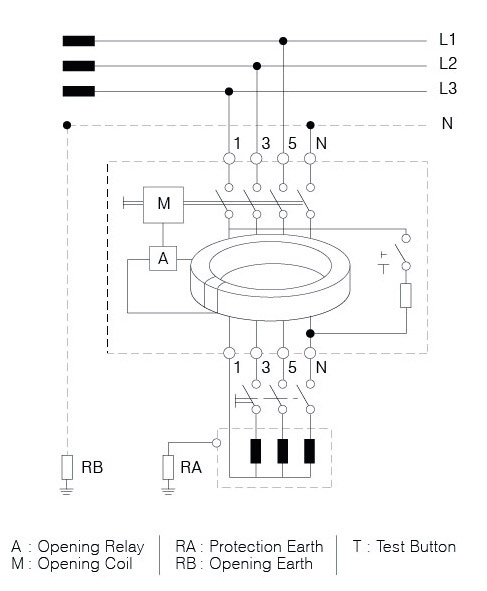A residual-current device (RCD), residual-current circuit breaker (RCCB), or ground-fault circuit interrupter (GFCI) is a device that quickly breaks an electrical circuit to prevent serious harm from an ongoing electric shock
According to India Regulation 36 of the Electricity Regulations 1990
a) For a place of public entertainment, protection against earth leakage current must be provided by a residual current device of sensitivity not exceeding 10 mA.
b) For a place where the floor is likely to be wet or where the wall or enclosure is of low electrical resistance, protection against earth leakage current must be provided by a residual current device of sensitivity not exceeding 10 mA.
c) For an installation where hand-held equipment, apparatus, or appliance is likely to be used, protection against earth leakage current must be provided by a residual current device of sensitivity not exceeding 30 mA.
d) For an installation other than the installation in (a), (b), and (c), protection against earth leakage current must be provided by a residual current device of sensitivity not exceeding 100 mA.
Double Pole (DP)


RCD sensitivity is expressed as the rated residual operating current, noted IΔn. Preferred values have been defined by the IEC, thus making it possible to divide RCDs into three groups according to their IΔn value:
high sensitivity (HS): 5** – 10 – 30 mA (for direct-contact or life injury protection),
medium sensitivity (MS): 100 – 300 – 500 – 1000 mA (for fire protection),
low sensitivity (LS): 3 – 10 – 30 A (typically for protection of machine).
The 5 mA sensitivity is typical for GFCI outlets.
In the internal mechanism of an RCD, the incoming supply and the neutral conductors are connected to the terminals at (1), and the outgoing load conductors are connected to the terminals at (2). The earth conductor (not shown) is connected through from supply to load uninterrupted. When the reset button (3) is pressed, the contacts ((4) and another, hidden behind (5)) close, allowing current to pass. The solenoid (5) keeps the contacts closed when the reset button is released.
The sense coil (6) is a differential current transformer which surrounds (but is not electrically connected to) the live and neutral conductors. In normal operation, all the current down the live conductor returns up the neutral conductor. The currents in the two conductors are therefore equal and opposite and cancel each other out.
Technical Details for RCCB Selection
No. of Poles
Rated Current (In)A
Rated Voltage (Ue)V~
Rated Frequency (f)Hz
Short Circuit Withstand Capacity
Short Circuit Breaking Performance
Rated Conditional Short-circuit (Inc)
Rated Conditional Residual Short-circuit Current (IΔc)
Rated Making and Breaking Capacity (Im)
Rated Residual Making and Capacity (IΔm)
Mode
Rated Impulse Voltage
Vibration Resistance
Dielectric Strength
Protection Class
Mounting
Connections

RCCB works on the principle that in electrical circuits the incoming current is the same as the outgoing current as shown in the diagram. RCCB incorporates a core balance transformer (CBT) having primary and secondary windings with sensitive relay for instantaneous detection of fault signals. The primary winding lies in series with the supply mains and load. The secondary winding is connected to a very sensitive relay. In faultless condition, the magnetizing effects of current-carrying conductors cancel each other. There is no residual magnetic field that can induce a voltage in the secondary. During the flow of leakage current in the circuit, an imbalance is created in the circuit which gives rise to leakage flux in the core. This leakage flux generates an electrical signal that is sensed by the relay and it trips the mechanism thereby disconnecting the supply.
The trip mechanism is operated at a Residual Current between 60-80% of its Rated Leakage Current.
When pressing the TEST button ‘T’ (during load conditions) a fault is simulated via the test resistance and RCCB trips







No comments:
Post a Comment